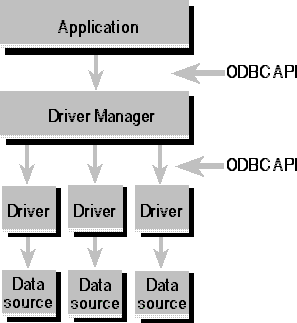The ODBC architecture has four components:
![]() Application. Performs processing and calls ODBC functions to submit SQL statements and
retrieve results.
Application. Performs processing and calls ODBC functions to submit SQL statements and
retrieve results.
![]() Driver Manager. Loads and unloads drivers on behalf of an application. Processes ODBC
function calls or passes them to a driver.
Driver Manager. Loads and unloads drivers on behalf of an application. Processes ODBC
function calls or passes them to a driver.
![]() Driver. Processes ODBC function calls, submits SQL requests to a specific data
source, and returns results to the application. If necessary, the driver modifies an
application’s request so that the request conforms to syntax supported by the
associated DBMS.
Driver. Processes ODBC function calls, submits SQL requests to a specific data
source, and returns results to the application. If necessary, the driver modifies an
application’s request so that the request conforms to syntax supported by the
associated DBMS.
![]() Data source. Consists of the data the user wants to access and its associated operating
system, DBMS, and network platform (if any) used to access the DBMS.
Data source. Consists of the data the user wants to access and its associated operating
system, DBMS, and network platform (if any) used to access the DBMS.
The following figure shows the relationship between these four components.

Note the following about this diagram. First, multiple drivers and data sources can exist, which allows the application to simultaneously access data from more than one data source. Second, the ODBC API is used in two places: between the application and the Driver Manager, and between the Driver Manager and each driver. The interface between the Driver Manager and the drivers is sometimes referred to as the service provider interface, or SPI. For ODBC, the application programming interface (API) and the service provider interface (SPI) are the same; that is, the Driver Manager and each driver have the same interface to the same functions.